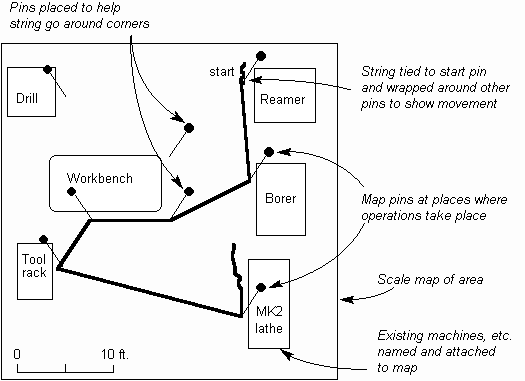String Diagram: How to do it
The Quality Toolbook >
String Diagram > How to do it
When to use it | How to understand it |
Example | How to do it | Practical
variations
<-- Previous |
Next -->
How to do it
- Identify the process to be analyzed. This will be one which involves a significant amount of movement by people, materials or both.
- Produce a scale map of the work area, not including machines, but including items that cannot easily be moved, such as power points, air lines, etc. This may be available from the site office.
- Add all machines, furniture and other equipment to the diagram. If possible, do this in a way that will allow these to be moved, for example by using shaped pieces of card that can be pinned to the work area map from step 2.
- Identify the points in the process where actions take place and mark the positions of these on the map with map pins.
Where there are different action types, these can be differentiated by marking or pinning down paper action symbols (typically the same as those used in the
Flow Process Chart).
- Tie the end of a piece of string to the pin where the process starts, and then wrap it around each pin in turn, following the movement around the process, as in the figure below. Tie the string off at the last position (which may be the start point, if the person returns there).
- Mark the string at the start and finish points, using a pen. Remove the string and measure between the penmarks, using the map scale. This will give the total distance traveled during the process.

Fig. 1. Pins and string - Rearrange the movable items on the map, aiming to reduce the total distance as measured in step 6. It may be appropriate to change what is done during the process at the same time. For example, some operations may be combined or eliminated. Strategies for deciding layouts include:
- Mobility
. Rearrange items and movements around fixed or immovable items, such as heavy machines.
- Function
. Put machines or people together that perform the same function. This is useful when varying loads may be shared between machines.
- Product
. Put machines or people together that make the same product. This works well when each machine is used for only one product.
- Repeat steps 4 to 6, to get a new total distance traveled. Using the same piece of string will make it easy to see how much shorter this is.
- Check that it is feasible to move equipment as planned in step 7, then do so. Measure the final process in practice to check that improvements are as expected.
<-- Previous |
Next -->
|